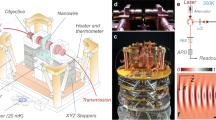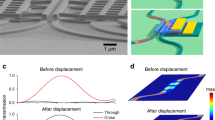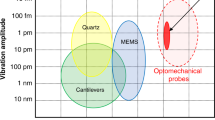Abstract
Nanoscale mechanical oscillators1 are used as ultrasensitive detectors of force2, mass3 and charge4. Nanomechanical oscillators have also been coupled with optical and electronic resonators to explore the quantum properties of mechanical systems5. Here, we report an optomechanical transducer in which a Si3N4 nanomechanical beam6,7 is coupled to a disk-shaped optical resonator made of silica on a single chip. We demonstrate a force sensitivity of 74 aN Hz−1/2 at room temperature with a readout stability better than 1% at the minute scale. Our system is particularly suited for the detection of very weak incoherent forces, which is difficult with existing approaches because the force resolution scales with the fourth root of the averaging time8. By applying dissipative feedback9 based on radiation pressure, we significantly relax this constraint and are able to detect an incoherent force with a force spectral density of just 15 aN Hz−1/2 (which is 25 times less than the thermal noise) within 35 s of averaging time (which is 30 times less than the averaging time that would be needed in the absence of feedback). It is envisaged that our hybrid on-chip transducer could improve the performance of various forms of force microscopy8,10,11,12.
This is a preview of subscription content, access via your institution
Access options
Subscribe to this journal
Receive 12 print issues and online access
$259.00 per year
only $21.58 per issue
Buy this article
- Purchase on Springer Link
- Instant access to full article PDF
Prices may be subject to local taxes which are calculated during checkout




Similar content being viewed by others
References
Ekinci, K. L. & Roukes, M. L. Nanoelectromechanical systems. Rev. Sci. Instrum. 76, 061101 (2005).
Mamin, H. J. & Rugar, D. Sub-attonewton force detection at millikelvin temperatures. Appl. Phys. Lett. 79, 3358–3360 (2001).
Jensen, K., Kim, K. & Zettl, A. An atomic-resolution nanomechanical mass sensor. Nature Nanotech. 3, 533–537 (2008).
Cleland, A. & Roukes, M. A nanometre-scale mechanical electrometer. Nature 392, 160–162 (1998).
Kippenberg, T. J. & Vahala, K. J. Cavity optomechanics: back-action at the mesoscale. Science 321, 1172–1176 (2008).
Verbridge, S. S., Parpia, J. M., Reichenbach, R. B., Bellan, L. M. & Craighead, H. G. High quality factor resonance at room temperature with nanostrings under high tensile stress. J. Appl. Phys. 99, 124304 (2006).
Anetsberger, G. et al. Near-field cavity optomechanics with nanomechanical oscillators. Nature Phys. 5, 909–914 (2009).
Rugar, D., Budakian, R., Mamin, H. & Chui, B. Single spin detection by magnetic resonance force microscopy. Nature 430, 329–332 (2004).
Mancini, S., Vitali, D. & Tombesi, P. Optomechanical cooling of a macroscopic oscillator by homodyne feedback. Phys. Rev. Lett. 80, 688–691 (1998).
Balasubramanian, G. et al. Nanoscale imaging magnetometry with diamond spins under ambient conditions. Nature 455, 648–651 (2008).
Maze, J. R. et al. Nanoscale magnetic sensing with an individual electronic spin in diamond. Nature 455, 644–647 (2008).
Arcizet, O. et al. A single nitrogen-vacancy defect coupled to a nanomechanical oscillator. Nature Phys. 7, 879–883 (2011).
LaHaye, M., Buu, O., Camarota, B. & Schwab, K. Approaching the quantum limit of a nanomechanical resonator. Science 304, 74–77 (2004).
Etaki, S. et al. Motion detection of a micromechanical resonator embedded in a d.c. squid. Nature Phys. 4, 785–788 (2008).
Teufel, J. D., Donner, T., Castellanos-Beltran, M. A., Harlow, J. W. & Lehnert, K. W. Nanomechanical motion measured with an imprecision below that at the standard quantum limit. Nature Nanotech. 4, 820–823 (2009).
Anetsberger, G. et al. Measuring nanomechanical motion with an imprecision below the standard quantum limit. Phys. Rev. A 82, 061804 (2010).
Biercuk, M. J., Uys, H., Britton, J. W., VanDevender, A. P. & Bollinger, J. J. Ultrasensitive detection of force and displacement using trapped ions. Nature Nanotech. 5, 646–650 (2010).
Knünz, S. et al. Injection locking of a trapped-ion phonon laser. Phys. Rev. Lett. 105, 013004 (2010).
Degen, C. L., Poggio, M., Mamin, H. J., Rettner, C. T. & Rugar, D. Nanoscale magnetic resonance imaging. Proc. Natl Acad. Sci. USA 106, 1313–1317 (2009).
Arlett, J. L., Myers, E. B. & Roukes, M. L. Comparative advantages of mechanical biosensors. Nature Nanotech. 6, 203–215 (2011).
Srinivasan, K., Miao, H., Rakher, M. T., Davanço, M. & Aksyuk, V. Optomechanical transduction of an integrated silicon cantilever probe using a microdisk resonator. Nano Lett. 11, 791–797 (2011).
Li, M., Pernice, W. H. P. & Tang, H. X. Reactive cavity optical force on microdisk-coupled nanomechanical beam waveguides. Phys. Rev. Lett. 103, 223901 (2009).
Kippenberg, T. J., Kalkman, J., Polman, A. & Vahala, K. J. Demonstration of an erbium-doped microdisk laser on a silicon chip. Phys. Rev. A 74, 051802 (2006).
Vernooy, D. W., Ilchenko, V. S., Mabuchi, H., Streed, E. W. & Kimble, H. J. High-Q measurements of fused-silica microspheres in the near infrared. Opt. Lett. 23, 247–249 (1998).
Cai, M., Painter, O. & Vahala, K. J. Observation of critical coupling in a fiber taper to a silica-microsphere whispering-gallery mode system. Phys. Rev. Lett. 85, 74–77 (2000).
Mertz, J., Marti, O. & Mlynek, J. Regulation of a microcantilever response by force feedback. Appl. Phys. Lett. 62, 2344–2346 (1993).
Cohadon, P. F., Heidmann, A. & Pinard, M. Cooling of a mirror by radiation pressure. Phys. Rev. Lett. 83, 3174–3177 (1999).
Kleckner, D. & Bouwmeester, D. Sub-kelvin optical cooling of a micromechanical resonator. Nature 444, 75–78 (2006).
Arcizet, O. et al. High-sensitivity optical monitoring of a micromechanical resonator with a quantum-limited optomechanical sensor. Phys. Rev. Lett. 97, 133601 (2006).
Poggio, M., Degen, C. L., Mamin, H. J. & Rugar, D. Feedback cooling of a cantilever's fundamental mode below 5 mK. Phys. Rev. Lett. 99, 017201 (2007).
Poot, M., Etaki, S., Yamaguchi, H. & van der Zant, H. S. J. Discrete-time quadrature feedback cooling of a radio-frequency mechanical resonator. Appl. Phys. Lett. 99, 013113 (2011).
Yasumura, K. et al. Quality factors in micron- and submicron-thick cantilevers. J. Microelectromech. Syst. 9, 117–125 (2000).
Rivière, R. et al. Optomechanical sideband cooling of a micromechanical oscillator close to the quantum ground state. Phys. Rev. A 83, 063835 (2011).
Van der Sar, T. et al. Nanopositioning of a diamond nanocrystal containing a single nitrogen-vacancy defect center. Appl. Phys. Lett. 94, 173104 (2009).
Schell, A. W. et al. A scanning probe-based pick-and-place procedure for assembly of integrated quantum optical hybrid devices. Rev. Sci. Instrum. 82, 073709 (2011).
Acknowledgements
Fabrication was carried out at the Center of MicroNanotechnology (CMi) at EPFL. The authors acknowledge financial support from NCCR Quantum Photonics, the DARPA Orchid programme, the SNF and an ERC starting grant (SIMP).
Author information
Authors and Affiliations
Contributions
T.J.K. and E.G. conceived the hybrid transducer. E.G. performed the fabrication and modelling. P.V. designed and conceived the incoherent force resolution enhancement scheme and performed the theoretical calculations. E.G. and P.V. performed the measurements and analysed the data. E.G. and P.V. wrote the manuscripts with critical comments from T.J.K. All stages of the work were supervised by T.J.K.
Corresponding authors
Ethics declarations
Competing interests
The authors declare no competing financial interests.
Supplementary information
Supplementary information
Supplementary information (PDF 1058 kb)
Rights and permissions
About this article
Cite this article
Gavartin, E., Verlot, P. & Kippenberg, T. A hybrid on-chip optomechanical transducer for ultrasensitive force measurements. Nature Nanotech 7, 509–514 (2012). https://doi.org/10.1038/nnano.2012.97
Received:
Accepted:
Published:
Issue Date:
DOI: https://doi.org/10.1038/nnano.2012.97
This article is cited by
-
Integrated microcavity electric field sensors using Pound-Drever-Hall detection
Nature Communications (2024)
-
Simultaneous cavity cooling of all six degrees of freedom of a levitated nanoparticle
Nature Physics (2023)
-
Entanglement-enhanced optomechanical sensor array with application to dark matter searches
Communications Physics (2023)
-
A whispering-gallery scanning microprobe for Raman spectroscopy and imaging
Light: Science & Applications (2023)
-
Entanglement-enhanced optomechanical sensing
Nature Photonics (2023)



